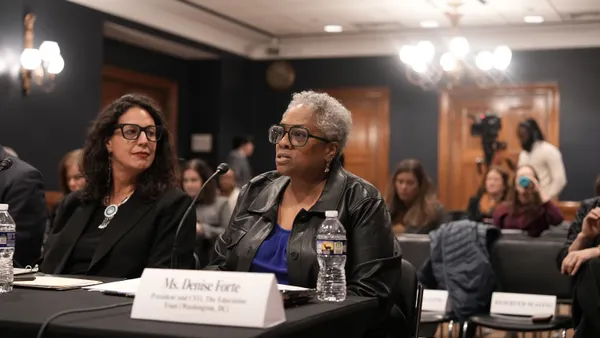Nationally, about 400,000 children and youth are in foster care, and research suggests they are at high risk of dropping out of school and unlikely to attend, or graduate from, college.
One in four children in foster care show signs of post-traumatic stress disorder, according to AdoptUSKids. And foster children in general move around, and change schools, more than the overall student population due to change in placements. Both factors can impair their ability to learn and feel connected to their schools.
So how can school districts improve educational outcomes for students in foster care? It starts with having thorough knowledge of their educational rights, which are aimed at giving these children the best chance at success, said Jill C. Rowland, education program director for the Los Angeles-based Alliance for Children’s Rights. “It’s about devoting the time and energy and resources to understanding the law, and creating policies and practices to that effect,” she said.
Here are six best practices recommended to increase the likelihood of success for children in foster care.
Maintain school stability
It’s imperative to maintain, as much as possible, school stability for students, which is one of tenets of the 2015 Every Student Succeeds Act.
“Instability wreaks havoc on education,” Rowland said.
Krissa Ericson, foster care program supervisor at Broward County Public Schools in Florida, agreed. The district has about 1,500 foster students among its 256,000 students.
“Foster students heal in relationships. We know they’ve been through pain and they’re hurting, so … whether it’s that teacher, that person in the lunchroom, those friends — we have to maintain those relationships as much as we can,” Ericson said.
Transportation is the main hurdle for students to remain in their original school, so districts and child welfare agencies need to work together on funding and logistics, Rowland said. If attending their school of origin is not in the foster student’s best interest — for example, if it entails an unreasonably long commute — the new district should enroll foster students as quickly as possible, Rowland said.
“Even if they don’t have an IEP [individualized education program] or transcript or uniform, they can come with nothing and have the ability to be enrolled,” she said.
“When in doubt, enroll,” said Cesar Casarrubias, director of pupil resources for Pomona Unified School District in California. “You do your due diligence, but the safest place for any child is school.”
Do a thorough intake
When a change of schools has to happen, Ericson said, everyone needs to work together to plan as smooth a transition as possible. That in turn helps defray students’ anxiety, Ericson said.
Schools should set up a thorough intake process to rigorously review students’ educational records, get them into the right classroom, and identify needed support services , said Mark Rodgers, senior director of student services for Bonita Unified School District in California.
Ideally, schools should have a trained staff member for that, Rodgers said. “You need a systematic approach so you have dependable, predictable systems.”
Sometimes, it’s not immediately clear students are in foster care, so intake staff should be trained to keep an eye out for things like students living with grandparents and sensitively ask questions to figure out if the courts are involved, Rowland said. “Staff has to be trained in the law, but also ask trauma-informed questions and be super sensitive around that so we are not retraumatizing them,” she said.
Be knowledgeable about rights
Schools must know the educational rights of foster youth — and ensure they are respected, Rowland said.
For example, in some states, foster students in high school who move during the semester have the right to obtain partial credit for classes, so they can earn a full semester’s worth of credit between different schools. That means districts should have student information systems programmed to issue partial credit, as well as staff in charge of paying attention to foster students’ transcripts and requesting partial credit from teachers, Rowland said.
“You have to be really intentional about doing it. You have to invest in training and resources,” she said.
Some states also have laws stating high school students can graduate meeting only their state’s graduation requirements, without the obligation to meet any additional requirements from local school districts.
Hire specific staff
Students in foster care are best served by trained staff, experts said.
Broward County Public Schools has a three-member foster care program team that serves as an “information hub” and works with community partners and staff liaisons at each school, Ericson said.
Bonita Unified School District has two full-time social workers who supervise a team of nine social work interns, all with the primary task of working with foster students. The district enrolls 250 to 300 foster students each year among its 10,000 students.
Social workers can help foster students with practical things, like getting uniforms if they make a school sports team, alongside academic matters like navigating college applications and applying for federal student aid. The social workers also communicate with teachers and help foster students in cases of disciplinary action, Rodgers said.
Having staff assigned to work with foster students is a financial commitment, “but on some level, there is no substitution for one person working individually with the kids,” Rodgers said.
Provide on-site mentorship
Pomona Unified School District partners with local nonprofits to offer mentorship for at-risk students, including one that provides on-site mentors specifically for foster students, Casarrubias said. The district has about 300 students in foster care out of about 20,000 students.
“Once we have identified foster students new to the district, we automatically make the referral to do outreach. Mentors introduce them to programs, give them support, and measure their needs,” he said. “It is optional, because you don’t want to push kids to do that, but they make sure they reach out and they offer their support.”
Much like social work staff at Bonita Unified School District, the mentors in Pomona USD help ensure foster students stay on a pathway to college, keeping an eye on their grades and communicating with teachers to see what additional support might be needed. “Regardless of what the need is for the child, that mentor can help,” Casarrubias said.
Keep trauma-informed approaches top of mind
Staff should be trained in an inclusive and trauma-informed approach for working with foster students, Casarrubias said.
Teachers should be sensitive about seemingly innocuous topics, he said. For example, asking“How was your holiday?” after a school break can be triggering for foster youth with challenging lives.
The COVID-19 pandemic underscored the importance of investing in mental health resources and social-emotional curricula, which is great for all students and especially important for foster students, Rowland said.
Helpful approaches include schoolwide positive behavior intervention, restorative justice instead of punitive discipline, and mindfulness lessons, Rowland said. “In the work that we do, for anybody who’s an educator, it’s all about putting kids’ needs first.”






 Dive Awards
Dive Awards











